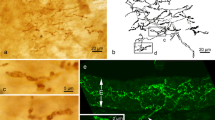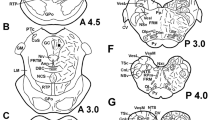Summary
The role of substance P in the regulation of secretion from sustentacular cells, Bowman's glands and deep glands in the amphibian olfactory mucosa was investigated using immunohistochemical, electrophysiological, and pharmacological methods. Substance P-like immunoreactive varicose fibers extended through the olfactory epithelium, terminating at or near the surface. In addition, immunoreactive varicose fibers innervated Bowman's glands, deep glands, and blood vessels in the lamina propria. Innervation of Bowman's gland was sparse, with fibers terminating on basal acinar cell membranes; deep gland innervation was abundant, with fibers often extending between acinar cells almost to the lumen. Stimulation of the ophthalmic branch of the trigeminal nerve resulted in slow potentials recorded at the surface of the olfactory epithelium. When the olfactory mucosae from trigeminal-stimulated animals were examined histologically, morphological signs of secretory activity were observed, suggesting that substance P was released from the trigeminal nerve terminals. Topical application of 10-5 to 10-3 mol substance P resulted in morphological signs of secretion that were very similar to those seen as a result of trigeminal stimulation. Thus, substance P released from trigeminal fibers may modulate secretory activity within the olfactory mucosa.
Similar content being viewed by others
References
Bertmar G (1980) Phagocytic and immunological cells in the olfactory mucosa of migrating Baltic sea trout. In: van der Starre H (ed) Olfaction and Taste VII. IRL Press Ltd, London, pp 159–162
Bouvet JF, Godinot F, Croze S, Delaleu JC (1987a) Trigeminal substance P-like immunoreactive fibres in the frog olfactory mucosa. Chem Senses 12:499–505
Bouvet JF, Delaleu JC, Holley A (1987b) Olfactory receptor cell function is affected by trigeminal nerve activity. Neurosci Lett 77:181–186
Bouvet JF, Delaleu JC, Holley A (1988) The activity of olfactory receptor cells is affected by acetylcholine and substance P. Neurosci Res 5:214–223
Couture R, Cuello AC (1984) Studies on the trigeminal antidromic vasodilation and plasma extravasation in the rat. J Physiol 346:273–285
Eskay RL, Furness JF, Long RT (1981) Substance P activity in the bullfrog retina: Localization and identification in several vertebrate species. Science 212:1049–1051
Finger TE, Getchell ML, Getchell TV, Kinnamon JC (1988) Affector and effector functions of peptidergic innervation of the nasal cavity. In: Green BG, Mason JR, Kare MR (eds) Chemical Irritation in the Nose and Mouth. Marcel Dekker, New York (in press)
Getchell ML, Getchell TV (1984) β-Adrenergic regulation of the secretory granule content of acinar cells in olfactory glands of the salamander. J Comp Physiol A 155:435–443
Getchell ML, Rafols JA, Getchell TV (1984) Histological and histochemical studies of the secretory components of the salamander olfactory mucosa: effects of isoproterenol and olfactory nerve section. Anat Rec 208:553–565
Getchell ML, Finger TE, Getchell TV (1987a) Localization of NGF-like, VIP-like, substance P-like and CGRP-like immuno-reactivity in the olfactory mucosae of the salamander, bullfrog and grass frog (abs). Chem Senses 12:658
Getchell ML, Zielinski B, DeSimone JA, Getchell TV (1987b) Odorant stimulation of secretory and neural processes in the salamander olfactory mucosa. J Comp Physiol A 160:155–168
Getchell ML, Zielinski B, Getchell TV (1988) Odorant and autonomic regulation of secretion in the olfactory mucosa. In: Margolis FL, Getchell TV (eds) Molecular Biology of the Olfactory System. Plenum, New York, pp 71–98
Getchell TV (1977) Analysis of intracellular recordings from salamander olfactory epithelium. Brain Res 329:382–387
Getchell TV (1986) Functional properties of vertebrate olfactory receptor neurons. Physiol Rev 66:772–818
Getchell TV, Margolis FL, Getchell ML (1984) Perireceptor and receptor events in vertebrate olfaction. Prog Neurobiol 23:317–345
Hökfelt T, Kellerth JO, Nilsson G, Pernow B (1975) Substance P: Localization in the central nervous system and some primary sensory neurons. Science 190:889–890
Jancsó G (1981) Intracisternal capsaicin: Selective degeneration of chemosensitive primary sensory afferents in the adult rat. Neurosci Lett 27:41–45
Lee Y, Kawai Y, Shiosaka S, Takami K, Kiyama H, Hillyard CJ, Girgis S, Maclntyre I, Emson PC, Tohyama M (1985) Coexistence of calcitonin gene-related peptide and substance P-like peptide in single cells of the trigeminal ganglion of the rat: immunohistochemical analysis. Brain Res 330:194–196
Lembeck F, Gamse R (1982) Substance P in peripheral sensory processes. In: Porter R, O'Connor M (eds) Substance P in the nervous system. Ciba Foundation Symposium 91, Pitman, London, pp 35–54
Lembeck F, Holzer P (1979) Substance P as neurogenic mediator of antidromic vasodilation and neurogenic plasma extravasation. Naunyn-Schmiedeberg's Arch Pharmacol 310:175–183
Liang T, Cascieri MA (1981) Substance P receptor on parotid cell membranes. J Neurosci 1:1133–1141
Lundblad L, Lundberg JM, Anggard A (1984) Local and systemic capsaicin pretreatment inhibits sneezing and the increase in nasal vascular permeability induced by certain chemical irritants. Naunyn-Schmiedeberg's Arch Pharmacol 326:254–261
Mantyh PW, Goedert M, Hunt SP (1984) Autoradiographic visualization of receptor binding sites for substance P in the gastrointestinal tract of the guinea pig. Eur J Pharmacol 100:133–134
Okano M, Takagi SF (1974) Secretion and electrogenesis of the supporting cell in the olfactory epithelium. J Physiol 242:353–370
Papka RE, Matulionis DH (1983) Association of substance P-immunoreactive nerves with the murine olfactory mucosa. Cell Tissue Res 230:517–525
Pernow B (1983) Substance P. Pharmacol Rev 35:85–141
Persaud KC, DeSimone JA, Getchell ML, Heck GL, Getchell TV (1987) Ion transport across the frog olfactory mucosa: the basal and odorant-stimulated states. Biochim Biophys Acta 902:65–79
Quinton PM (1981) Possible mechanisms of stimulus-induced vacuolation in serous cells of tracheal secretory glands. Am J Physiol 241:C25-C32
Rafols JA, Getchell TV (1983) Morphological relations between the receptor neurons, sustentacular cells and Schwann cells in the olfactory mucosa of the salamander. Anat Rec 206:87–101
Renner H, Foreman JC, Jordan CC, Oehme P (1982) Histamine release from mast cells by substance P and substance P sequences. Pharmazie 37:866
Saini KD, Breipohl W (1977) Frequency of mast cells in the olfactory mucosa of Rhesus monkeys. Cell Tissue Res 178:61–71
Saria A, Lundberg JM (1984) Activiation of sensory substance P neurones in the respiratory tract by cigarette smoke, mechanical and chemical irritants. Front Horm Res 12:123–126
Silver WL, Moulton DG (1982) Chemosensitivity of rat nasal trigeminal receptors. Physiol Behav 28:927–931
Silver WL, Mason JR, Marshall DA, Maruniak JA (1985) Rat trigeminal, olfactory and taste responses after capsaicin desensitization. Brain Res 333:45–54
Silver WL, Mason JR, Adams MA, Smeraski CA (1986) Nasal trigeminal chemoreception: responses to n-aliphatic alcohols. Brain Res 376:221–229
Sjodin L, Brodin E, Srivastava G (1984) Interaction of substance P with dispersed pancreatic cells from the guinea pig. Acta Physiol Scand 120:21–26
Stefanini M, De Martino C, Zamboni L (1967) Fixation of ejaculated spermatozoa for electron microscopy. Nature 216:173–174
Tucker D (1963) Physical variables in the olfactory stimulation process. J Gen Physiol 46:453–489
Tucker D (1971) Nonolfactory responses from the nasal cavity: Jacobson's organ and the trigeminal system. In: Beidler LM (ed) Handbook of Sensory Physiology Vol IV Chemical Senses 1 Olfaction. Springer, Berlin Heidelberg New York, pp 151–181
Ulrich CE, Haddock MP, Alarie Y (1972) Airborne chemical irritants. Role of the trigeminal nerve. Arch Environ Health 24:37–42
Wong-Riley MTT (1974) Synaptic organization of the inner plexiform layer in the retina of the tiger salamander. J Neurocytol 3:1–33
Zielinski BS, Getchell ML, Getchell TV (1988) Ultrastructural characteristics of sustentacular cells in control and odorant-treated olfactory mucosae of the salamander. Anat Rec 221:769–779
Author information
Authors and Affiliations
Rights and permissions
About this article
Cite this article
Getchell, M.L., Bouvet, JF., Finger, T.E. et al. Peptidergic regulation of secretory activity in amphibian olfactory mucosa: Immunohistochemistry, neural stimulation, and pharmacology. Cell Tissue Res. 256, 381–389 (1989). https://doi.org/10.1007/BF00218896
Accepted:
Issue Date:
DOI: https://doi.org/10.1007/BF00218896




